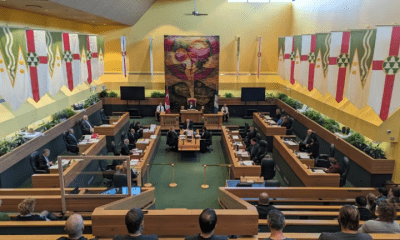Art and Culture
Dom Martin’s vestments: Indigenized robes for worship
MANILA, June 13 — A collection of 60 liturgical vestments from 20 ethno-linguistic groups is currently on display at the Ayala Museum in Makati City.
The exhibit, entitled “Vested for Worship, Wrapped in Identity”, showcases the designs of Benedictine monk, Dom Martin Hizon Gomez, OSB from the Abbey of the Transfiguration in Malaybalay, Bukidnon.
Dom Martin studied at the SLIMS Fashion and Arts School from 1967-1968 and had a 22-year career as a fashion designer before entering the monastery.
The Catholic Church has quite recently adopted the concept of “enculturation”, which means that songs — and now vestments — can be indigenized. Vestments can make use of fabrics belonging to the cultural identity of each parish.
Amazed by the country’s rich cultural heritage, Dom Martin was prompted to ask, “We have all these beautiful materials. How come we never use them for the Church?”
Dom Martin however had to make certain that fabrics and other ornaments from the various ethno-linguistic groups in the country remain available. “If I am going to promote the use of indigenous materials, I should be assured of the supply. I know they are beautiful but do people still weave them? I might be creating a market but then all of a sudden, there might be no supply,” he said.
Acting as his own researcher and anthropologist, Dom Martin set out on a journey that would take him from his native Mindanao to the northernmost parts of Luzon in search of the best materials that would represent the ethno-linguistic groups of the Philippines.
It was a project that would take him four-and-a-half years to complete. Dom Martin traveled and studied 20 ethno-linguistic groups to make sure they are still weaving and can weave for the Church.
The monk sought the help of the Philippine Textile Research Institute (PTRI), Fiber Industry Development Authority (FIDA), and the Katutubong Pilipino Foundation, whose chairperson Margie Macasaet encouraged him to create a whole collection in time for the Philippine Centennial Celebrations in 1998.
He also checked with his embroiderers in Parañaque and Las Piñas to see if they were still around and working. They were only too glad to help with his project.
“I was very blessed that all the people I approached believed in what I wanted to do — to enculturate liturgical vestments and make them Filipino,” Dom Martin said.
In the field while doing research, Dom Martin realized how remote and inaccessible some of these indigenous groups were, for instance, the “Itneg” in Abra, which he reached after a long trek that included crossing a hanging bridge over a raging river.
“Two days later when I came home, I talked to my brother and I said, please get me an insurance policy. I did not realize this research was going to entail some danger,” he quipped.
The resulting pieces were nothing short of breathtaking. The vestments were done in a variety of fabrics, including abaca and “pinya”, and incorporated the colors of the Itneg, Gaddang, Ifugaos and many other indigenous peoples.
Each piece is totally rendered by hand. The ornaments and embroidery work are intricate and exquisite, fusing in such liturgical symbols as the cross, vines and branches.
According to Dom Martin, the simplicity of the vestments in the early days signified that the Church closely identified itself with the poor. This explains why he left out symbols on the stole –“stola” in Greek — which means “towel”.
“You do not put symbols on top of symbols. In the early ages, all of these vestments were ordinary clothing. The stola was just a towel that the men used to wipe their faces and hands,” he explained.
”Later on, they had to put emblems and different symbols for catechetical instruction. It served its purpose in those years but at this point in time, they are not strictly necessary, which is why my stoles do not have any additional symbols.”
We have to take pride in our heritage and culture and bring this pride and culture in our liturgical celebrations, he said.
”Only then can we say that our worship has become truly Filipino. Enculturating vestments is very important because when a priest celebrates the Holy Eucharist wearing a vestment using indigenous materials, he is not only clothed for worship, he is wrapped in the Filipino identity,” Dom Martin.
The exhibit runs at the Ayala Museum until September 5.






















